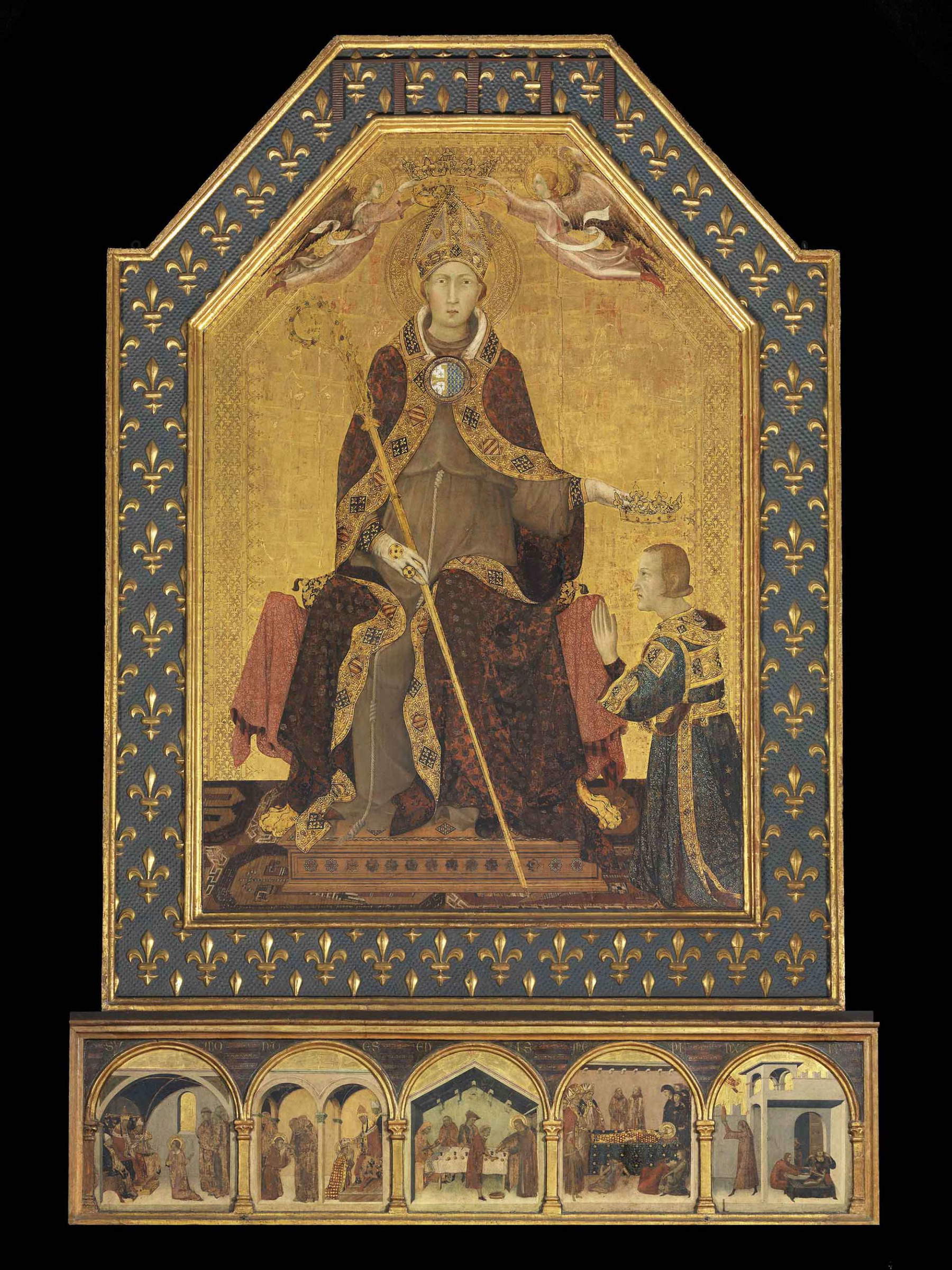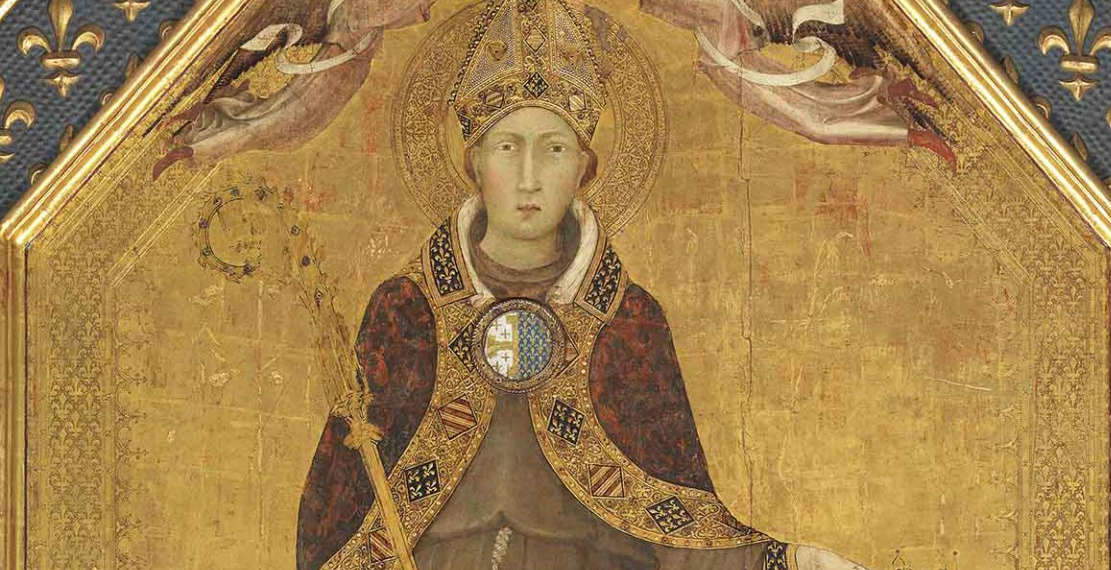The restoration of the great altarpiece of Saint Louis of Toulouse, a masterpiece by Simone Martini (Siena, 1284 - Avignon, 1344), as well as one of the most important works of the 14th century, linked to the city’s Angevin period, has begun at the Capodimonte Museum and Real Bosco in Naples. The intervention, which began this morning, represents a moment of extraordinary importance both from a scientific point of view and for the symbolic value of the work, a masterpiece of medieval painting that had not undergone extraordinary maintenance for more than sixty-five years.
The project stems from the first framework collaboration between the museum, directed by Eike Schmidt, and theOpificio delle Pietre Dure of Florence, a national and international excellence in the field of restoration. The formula adopted is that of the "educational workshop ," an on-sight laboratory set up in Room 66 on the second floor, the same room that has housed the monumental panel since 1966. The construction site will be open for about six months, allowing visitors to closely follow the stages of restoration. The ongoing restoration is thus configured as an opportunity for study and in-depth study. In fact, the “educational worksite” allows the work of the restorers to be documented and made accessible to the public, offering scholars new data on the artist’s execution technique and the painting’s conservation history. At the same time, it allows visitors to get closer to the behind-the-scenes of the restoration, turning a specialized activity into a cultural popularization experience.
"That of Simone Martini’s Saint Louis of Toulouse,“ Schmidt explains, ”can undoubtedly be called an epoch-making restoration, both because of the importance of the work, whose splendor has always fascinated visitors to Capodimonte, and because of its significance in the history of the city, particularly that of the flourishing Angevin Naples with its court of patrons in the heart of the Mediterranean. With emotion we recall that in 1966 it was Raphael Causa who last moved the great altarpiece from the wall to place it in its present position with an iron support that slightly detaches it from the wall. We thank the Opificio delle Pietre dure that shares with us this fascinating undertaking as part of an articulated collaboration for the restoration and study of an important nucleus of masterpieces including works by Titian, Mantegna, Dosso Dossi, Polidoro da Caravaggio, and Vivarini."
The operations will mainly concern the verso of the painting, with an in-depth study of the wooden structure and an intervention aimed at closing the disconnections and cracks in the support. They will also reconstruct any small deficiencies on the predella, fix the lily decoration on the back, and consolidate the polychrome surface of the recto, particularly along the commectations of the panels that are partially compromised due to the movement of the wood.
The restoration is entrusted to a joint team: for Capodimonte, the curator of the 13th-, 14th- and 15th-century painting and sculpture collections, Alessandra Rullo, and restorers Alessia Zaccaria, Sara Vitulli and Loris Panzavecchia are in charge. Speaking for the Opificio delle Pietre Dure are superintendent Emanuele Daffra, director of painting and panel restoration Sandra Rossi and restorers Luciano Ricciardi, along with Ciro Castelli and Andrea Santacesaria.

The altarpiece depicting Saint Louis of Toulouse crowning his brother Robert of Anjou is considered the most significant 14th-century painting on panel related to the Angevin period in Naples. The work became part of the public collections in 1921, when it was acquired by the National Museum, now the National Archaeological Museum of Naples. In 1957 it was transferred to the Museo e Real Bosco di Capodimonte, which opened in the Bourbon Royal Palace that same year.
Historical sources place the altarpiece between the late 16th and early 17th centuries in the Franciscan church of San Lorenzo Maggiore in Naples, which is generally believed to be its original home. However, there is no shortage of alternative hypotheses linking it to Santa Chiara or the cathedral.
The history of the depicted saint is closely intertwined with the political and religious events of the Angevin kingdom. Ludovico, son of Charles II of Anjou and Mary of Hungary, renounced the throne in favor of his brother Robert to embrace religious life and the Franciscan order. He died in 1297 at only twenty-three years old and was canonized in 1317, the year in which historians place the execution of the painting. Two years later the Angevins transferred some relics of the saint to Naples from Marseilles, consolidating the cult and dynastic ties.
The altarpiece has come down to us incomplete, as the pilasters, cusps and a second panel placed at the top have been lost, but it still remains a work of monumental dimensions, exceeding three meters in height. The gilded surface, originally studded with gems, shows Ludovico seated on a throne, dressed in the Franciscan habit surmounted by the rich episcopal robes. Two angels crown him with the heavenly crown, while the saint himself places the crown of the Kingdom of Naples on his brother Robert’s head.
The predella depicts scenes from the saint’s life: the funeral after his death in Brignoles and a posthumous miracle, alongside the Sienese painter’s signature, “Symon de Senis me pinxit,” which testifies to the authorial pride of Simone Martini, among the leading figures of international Gothic painting.
In addition to its obvious artistic value, the altarpiece has enormous historical and political importance. Its commission was in response to the need to consolidate the prestige of the Angevin dynasty, intertwined with the Harpades of Hungary through the dynastic union of the two lineages. The iconography itself underscores this dimension: the coat of arms of the Kingdom of Jerusalem stands out on the buckle of Ludovico’s cope, while the bright blue frame, decorated with gold lilies, recalls the heraldry of the French Capetian dynasty from which the Angevins descended.
Artistically, the altarpiece represents one of Simone Martini’s most ambitious early works. Alongside his mastery of the tempera-on-board technique, the artist experimented with innovative solutions, adapting processes from other fields such as sculpture and metalwork. The result is a work that combines pictorial refinement and symbolic complexity, capable of embodying both Franciscan spirituality and the political celebration of the ruling dynasty.
With the recovery of the “Saint Louis of Toulouse,” Capodimonte strengthens its role as a museum capable of combining protection and enhancement, conservation and research. An approach that finds in the alliance with the Opificio delle Pietre Dure in Florence a guarantee of scientific rigor and technical excellence. When restoration is completed in six months, Simone Martini’s masterpiece can be returned to the public in optimal condition, renewing its function as an artistic and political witness to a crucial era in Neapolitan and European history.
 |
| Naples, restoration of San Ludovico, a masterpiece by Simone Martini, begins at Capodimonte |
Warning: the translation into English of the original Italian article was created using automatic tools. We undertake to review all articles, but we do not guarantee the total absence of inaccuracies in the translation due to the program. You can find the original by clicking on the ITA button. If you find any mistake,please contact us.